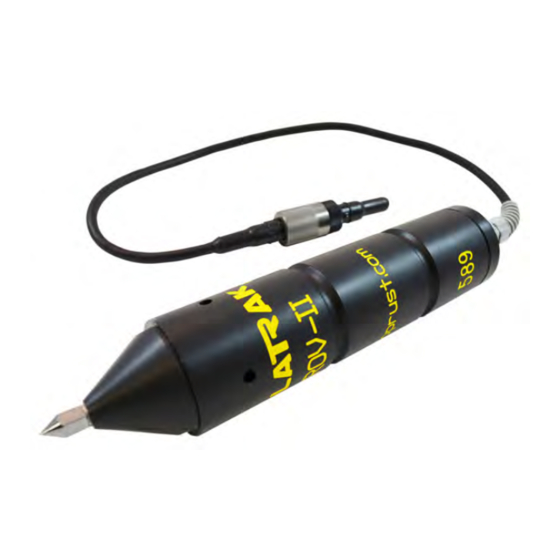Table of Contents
Advertisement
ROV-II™
CP probe
Operation manual
Twin reference
electrodes for
online calibration
Deepwater Corrosion Services Inc.
©
2016 Deepwater Corrosion Services Inc. Specifications subject to change without notice
Can be used with
ROVs or as a
diver-held probe
|
13813 FM 529 Rd, Houston, TX 77041 USA +1 (713) 983 7117
Works as either
Use with Polatrak
a contact or
Deep C Meter™
proximity probe
for subsea readout
|
Email: sales@stoprust.com
Corrosion testing probes
|
polatrak.com
SMB-009 ROV-II Manual Rev. 1
Advertisement
Table of Contents
Troubleshooting

Summary of Contents for Polatrak ROV-II
- Page 1 Deepwater Corrosion Services Inc. 13813 FM 529 Rd, Houston, TX 77041 USA +1 (713) 983 7117 Email: sales@stoprust.com polatrak.com SMB-009 ROV-II Manual Rev. 1 © 2016 Deepwater Corrosion Services Inc. Specifications subject to change without notice...
-
Page 2: Table Of Contents
Table 1 Normal cathodic protection ranges for bare carbon steel in seawater Table 2 Troubleshooting quick guide www.polatrak.com 13813 FM 529 Rd, Houston, TX 77041 USA Telephone: +1 (713) 983 7117 Email: sales@stoprust.com SMB-009 ROV-II Manual Rev. 1 2016 Deepwater Corrosion Services Inc. Specifications subject to change without notice ©... -
Page 3: Rov-Ii Components
Tail assembly Hex screws The Deep C Meter™ LED readout can be used with the ROV-II to record read- ings without utilizing the ROV’s umbilical. www.polatrak.com 13813 FM 529 Rd, Houston, TX 77041 USA Telephone: +1 (713) 983 7117 Email: sales@stoprust.com... -
Page 4: Reference Documents
2.1.1 Dow Corning – 4 Electrical Insulating Compound MSDS – connector sealant http://www.dowcorning.com/applications/search/products/details.aspx?prod=01903128&type=prod PLEASE CONTACT YOUR POLATRAK REPRESENTATIVE FOR ANY QUESTIONS AND/OR ISSUES REGARDING THIS MANUAL. 3. Health and safety It is the intention of Deepwater Corrosion that all test and inspection procedures are carried out in a safe manner in accordance with the Health and Safety At Work Act and any other relevant leg- islation. -
Page 5: Rov Installation
1 MΩ 4.3 Cautionary notes Polatrak sintered silver / silver chloride reference electrode elements are designed to be rugged, but they are consumables that have a given operational life. The life of these electrodes can be extended to several seasons if the following care is taken: 4.3.1... -
Page 6: Calibration
5. Calibration 5.1 General As with any subsea measurement device, it is important to calibrate the ROV-II probe to ensure that the reference electrodes are working properly and that there is no damage to the probe. If the probe is not calibrated, readings may be incorrect and the dive may have to be repeated. -
Page 7: Subsea Calibration
Pin socket 3: Reference electrode #2 (R2) 5.4 Subsea calibration The cell-to-cell value can be checked at any time while the ROV-II probe is deployed subsea. Subsea calibration should be performed with the entire cable immersed, as it will quickly detect any cable damage. -
Page 8: Proximity Mode Ground Check
13813 FM 529 Rd, Houston, TX 77041 USA Telephone: +1 (713) 983 7117 Email: sales@stoprust.com SMB-009 ROV-II Manual Rev. 1 2016 Deepwater Corrosion Services Inc. Specifications subject to change without notice ©... -
Page 9: Taking Cathodic Protection Potential Readings
Abort & refer to troubleshooting section www.polatrak.com 13813 FM 529 Rd, Houston, TX 77041 USA Telephone: +1 (713) 983 7117 Email: sales@stoprust.com SMB-009 ROV-II Manual Rev. 1 2016 Deepwater Corrosion Services Inc. Specifications subject to change without notice ©... -
Page 10: Maintenance And Repair
9.2 Reference electrode element replacement Spare plug-in electrode elements are available for the ROV-II probe. These elements will also work in the Polatrak CP Gun. If one element or more needs to be changed, follow this procedure: 9.2.1... -
Page 11: Troubleshooting
• There is damage to the tail assembly cable or umbilical cable. When recovering the ROV-II Probe from the dive, any cable damage can be quickly located and repaired. Monitor the cell-to-cell value as the cable comes out of the water. If the problem is cable damage, the cell-to-cell value will revert to the acceptable range (10 mV or less) as soon as the damaged area of cable clears the water. -
Page 12: Figure 4 Calibration Vs. Zinc Coupon
(Readings should be within ±0.005V of each other) www.polatrak.com 13813 FM 529 Rd, Houston, TX 77041 USA Telephone: +1 (713) 983 7117 Email: sales@stoprust.com SMB-009 ROV-II Manual Rev. 1 2016 Deepwater Corrosion Services Inc. Specifications subject to change without notice ©... -
Page 13: Figure 5 Calibration Cell-To-Cell
Reference electrode 2 / Pin 3 200 mV ±5.0 mV www.polatrak.com 13813 FM 529 Rd, Houston, TX 77041 USA Telephone: +1 (713) 983 7117 Email: sales@stoprust.com SMB-009 ROV-II Manual Rev. 1 2016 Deepwater Corrosion Services Inc. Specifications subject to change without notice ©... -
Page 14: Figure 6 Calibration Vs. Master Ag/Agcl Electrode
Tip / Pin 1 -3 V ± 0.1 V www.polatrak.com 13813 FM 529 Rd, Houston, TX 77041 USA Telephone: +1 (713) 983 7117 Email: sales@stoprust.com SMB-009 ROV-II Manual Rev. 1 2016 Deepwater Corrosion Services Inc. Specifications subject to change without notice ©... -
Page 15: Figure 7 Wiring Schematic For Diver-Assisted Platform Survey
2 Volts DC setting www.polatrak.com 13813 FM 529 Rd, Houston, TX 77041 USA Telephone: +1 (713) 983 7117 Email: sales@stoprust.com SMB-009 ROV-II Manual Rev. 1 2016 Deepwater Corrosion Services Inc. Specifications subject to change without notice ©... -
Page 16: Figure 8 Wiring Schematic For Deep C Meter™ Readout
Reference electrode #1 (R1) Pin 3: Reference electrode #2 (R2) www.polatrak.com 13813 FM 529 Rd, Houston, TX 77041 USA Telephone: +1 (713) 983 7117 Email: sales@stoprust.com SMB-009 ROV-II Manual Rev. 1 2016 Deepwater Corrosion Services Inc. Specifications subject to change without notice ©...




Need help?
Do you have a question about the ROV-II and is the answer not in the manual?
Questions and answers